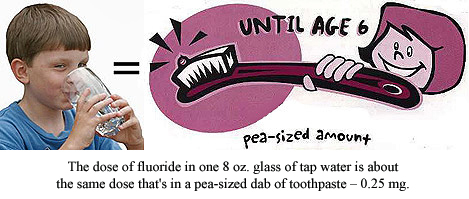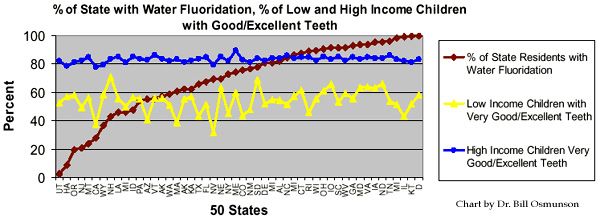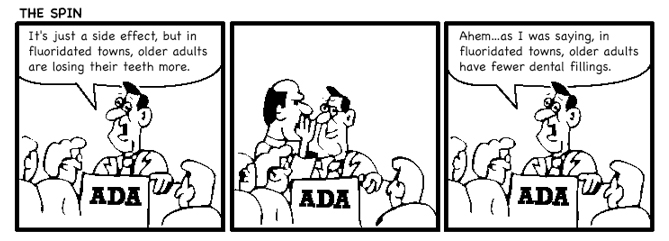This report is an expanded version of one published in Oregon Sierra Club's Wild Juniper Journal (Summer 2008). Based on federal and state government data, it includes extensive references.
Don't Be Takin' Fluoride
Deconstructing the Sales Pitch for Water Fluoridation
"A long habit of not thinking a thing wrong, gives it a superficial
A Reality Check by John D. MacArthur
appearance of being right." – Thomas Paine, Common Sense, 1776
Today many Americans do not think it's wrong to swallow fluoride in their drinking water, although they know not to swallow fluoride toothpaste because its label warns to "contact a Poison Control Center immediately" if, for example, a child ingests more than a pea-sized amount of toothpaste.
One reason for this contradiction is confusion about dosage. According to the U.S. Centers for Disease Control and Prevention (CDC), that pea-sized dab of toothpaste contains approximately one quarter-milligram (0.25 mg) of fluoride[1] – the same amount in only about one cup of fluoridated water – which begs the question: How can fluoride be healthy and safe in water, if the same dose is poisonous in toothpaste?

If it's poisonous for a child to swallow 0.25 mg of fluoride in toothpaste, then
why isn't it poisonous for that child to swallow 0.25 mg of fluoride in tap water?
But the main reason Americans don't think it's wrong to consume fluoride is because, for decades, authority figures have said so.
"You can get practically any idea accepted," chuckled Edward Bernays in an interview with Christopher Bryson. "If doctors are in favor, the public is willing to accept it, because a doctor is an authority to most people, regardless of how much he knows, or doesn't know." Considered the "father of public relations," Bernays helped persuade Americans in the 1950s to add fluoride to their drinking water.[2]
In his meticulously documented book, The Fluoride Deception, investigative journalist Christopher Bryson unearths the mystery of how the most damaging environmental pollutant of the Cold War era came to be injected into our drinking water after powerful industries facing extensive litigation collaborated with officials at the National Institute of Dental Research.
"In one of the greatest medical vanishing acts of the twentieth century, fluoride was systematically removed from public association with ill health by researchers funded by the U.S. military and big corporations" – despite prior serious warnings about fluoride's health risks from the Department of Agriculture and from both the American Medical and Dental Associations.[2a]
Dental Math
Deception is still at the heart of the fluoridation sales pitch. A prime example of what a mathematics professor called "blatant statistical misconduct"[3] is the flagship claim that drinking fluoridated water reduces children's tooth decay by (at least) 18%. Its source is a 1990 National Institute of Dental Research (NIDR) report based on data that "represented over 43 million children age 5-17 years" with either "life-long water fluoridation exposure" or none.
That 18% refers to an actual difference in tooth decay of only six-tenths (0.6) of one tooth surface – out of a total of more than 100 tooth surfaces. The data show that kids in fluoridated communities averaged 97.2 healthy undecayed tooth surfaces (based on 100 surfaces), while unfluoridated kids averaged 96.6. That 0.6 difference is less than 1% of the total, so this huge government study actually showed water fluoridation had an insignificant effect on the oral health of children.[4]
For five-year-olds, the NIDR reckons a mere seven-hundredths (0.07) of a tooth surface equals 70% less decay! And this study is the best evidence the CDC is still citing to support the need to add fluoride to drinking water.[4a]
Worse, here's a reality check we never hear about: in the most fluoridated region of the U.S., kids living in the fluoridated communities there had more tooth decay than kids living in that region's unfluoridated communities.[5]
"Half the Truth is often a great Lie." – Poor Richard's Almanack
This 250-year-old heads up by Ben Franklin applies especially to the sales pitch for water fluoridation, so it's crucial to discover what we are not being told. Therein lies the truth.
2000 Oral Health Report Card
A prime example of half-truth is the press release put out by Oregon Health & Science University (OHSU) School of Dentistry about the first national Oral Health Report Card. It began, "Oregon has nothing to smile about" and quickly pointed out the state got the worst grade for having one of America's lowest percentages of fluoridated water. Then came quotes from three dentists calling for mandatory statewide fluoridation.[6]
The press release failed to mention that Oregon got one of the best grades for its low percentage of kids with cavities. Only three states scored higher, and two of them also got poor grades for water fluoridation.
After national data revealed no correlation between increased water fluoridation and reduced cavities, this first Oral Health Report Card (endorsed by Surgeon General David Satcher) was taken out of circulation, and subsequent report cards no longer even measured kids' cavity rates – the purported rationale for water fluoridation in the first place.[7]
During the 2005 Oregon legislative session, the editorial board of The Bulletin (Bend, Oregon's daily newspaper) tried their best to deny the first report card's findings in their February 27th editorial, "A meaningful step toward fluoridation." But after being confronted with the facts, they printed an apology – acknowledging that a local nutritionist was correct when she said, "There just isn't any significant relationship between presence or absence of water fluoridation and cavity rate."
Disregarding this inconvenient truth, The Bulletin editors believe every man, woman, and child should consume the drug fluoride via their drinking water, because "there are times when it's perfectly appropriate for government to insist on real mass medication." ("Fluoride bill deserves Legislature's support," Jan. 2, 2005) – an oddly anachronistic belief for our era of genetic and individualized medicine, when we know one size does not fit all.[8]
Note: a provision in the U.S. Safe Drinking Water Act prohibits adding to our water any substance intended to treat people, as opposed to treating the water (which chlorine does). Fluoride, when ingested, is regulated as a drug by the FDA – a drug that's never been approved for safety or effectiveness.[9]
Despite recent nationwide health concerns about drugs in our water and government cautions about mixing infant formula with fluoridated water (which contains 250 times more fluoride than human breast milk),[9a] The Bulletin editorial board seems bent on medicating everyone in Bend by using the city's award-winning drinking water to deliver fluoride.
![]()

Source spring for Bend's drinking water.
2007 Oregon Smile Survey
The Bulletin editorial board (reported on Sep. 8, 2007 to consist of Gordon Black, Richard Coe, John Costa, Peg Cushman, Erik Lukens, Betsy McCool, and Janet Stevens) is now trying to use a recent statewide oral health survey to validate their belief that "were fluoridation more widespread in Oregon, the 2007 Oregon Smile Survey might actually contain something to smile about." ("Require fluoridation," Nov. 20, 2007) Citing Oregon's worsening dental health (not mentioning it's worsening nationwide), they question whether Oregon is "really part of a developed, first-world country" and call us a "population of public-health Luddites" because we're one of the least fluoridated states. ("Fluoridate already," April 25, 2008)
If members of The Bulletin editorial board think Oregonians are public-health Luddites, then they must think Swedes are downright Neanderthals, because Sweden outlawed water fluoridation in 1980, thanks in large part to Dr. Arvid Carlsson. This famed scientist who won the 2000 Nobel Prize in Medicine said water fluoridation is an obsolete practice that's "against all principles of modern pharmacology."
In an accompanying news story, The Bulletin repeated the myth that lack of fluoridated water is a cause of kids' problems and moaned that "Portland is the largest city in the United States that does not fluoridate its water." The Bulletin, however, neglected to mention the other half of the truth, a key finding in the 2007 Oregon Smile Survey: Children living in Portland actually had better dental health than the rest of Oregon.
In contrast, Oregon Department of Human Services (DHS) reported that "Children in the Portland metropolitan area have less untreated tooth decay, are less likely to have ever had a cavity and are less likely to need urgent dental treatment."[10] What DHS and The Associated Press ("Tooth decay on the rise, survey finds," Nov. 18, 2007) neglected to disclose was that Portland's water is not fluoridated.
Conspicuously absent from the Oregon 2007 Smile Survey was any evidence of the sales pitch's big promise. No reduction in kids' cavities were reported for artificially fluoridated Salem, Beaverton, or Corvallis.
Also missing was evidence of less tooth decay in children living in any of Oregon's 35 communities whose water systems have levels of natural (calcium) fluoride "considered optimal for protecting teeth."[11]
Despite the 2007 Oregon Smile Survey's findings that show water fluoridation is ineffective at reducing tooth decay, DHS blindly insists that as many Oregonians as possible need to swallow fluoride in their drinking water or via supplements.
DHS's other fluoride program is also a failure. In Oregon communities where water is not fluoridated, the agency's "King Fluoride School-Based Tablet Program feeds fluoride tablets to tens of thousands of students, even though DHS has no idea if their archaic program is effective and current dental research no longer even recommends fluoride supplements.[12]
What Oregon's Smile Survey did reveal was that low-income children and those without dental insurance had poorer oral health and less access to care. This is the same (and worsening) situation across the nation.

Regardless of water fluoridation status, poorer kids everywhere have more tooth decay.[13]
From similar Smile Surveys in 36 other states, the CDC has gathered tooth-decay data for third-grade students.[14] Again, the results show a weak correlation between water fluoridation status[15] and oral health. The kids living in 27%-fluoridated Oregon had about the same or less tooth decay than their counterparts in 12 other states that all had a greater percentage of fluoridated water, including 100%-fluoridated Kentucky.
Tooth decay is independent of water fluoridation status.[16] Tooth decay is a disease of poverty, poor oral hygiene, and lack of access to affordable dentists – not a lack of swallowed fluoride. And despite the sales pitch, fluoride is not a nutrient.[17]
'Side Effects' of Water Fluoridation
Ingesting fluoride for years not only fails to reduce tooth decay, it increases dental fluorosis, the visible indication of chronic excessive fluoride consumption. In fluoridated communities, 66% of America's children have dental fluorosis, while the overall rate among U.S. school children (age 6-19) is 32% and rising.[18]
The American Dental Association aggressively pushes water fluoridation, fully aware it increases fluorosis. This trade union, however, dismisses dental fluorosis as merely a "cosmetic" effect while its members increasingly promote, practice, and profit from cosmetic dentistry.[19]
Even more serious: fluoride adversely affects the thyroid gland, whose dysfunction in mothers is associated with mental retardation in their children.
Fractured Fairy Tale
Fluoride works topically, applied via toothpaste. Taken systemically, it doesn't actually strengthen teeth (as first believed). It makes them more brittle.[20]
The third most common cause of tooth loss is fractured teeth. Bill Osmunson, DDS, MPH (who practices dentistry in both Oregon and Washington) sees a connection between water fluoridation and tooth fracture. He estimates that when all the costs for treatment of dental fractures are considered, "the true lifetime cost for fractured teeth could represent the single greatest dental expense for adults."[21]
This overlooked costly side effect of water fluoridation is a reason why fluoridated cities do not have lower dental costs (a centerpiece of the fluoridation sales pitch), and refutes the often-parroted myth that every dollar spent on water fluoridation saves $38 in dental costs.[22]
According to 2004 CDC data, seniors in Oregon had less tooth loss than seniors in 33 other states that all had a greater percentage of fluoridated water than Oregon.[23] That's something else the 2000 Oral Health Report Card revealed but not mentioned by OHSU dentists, DHS, and other members of Oregon's Fluoride-For-All Lobby (OFFAL): Oregon also got a high grade for the percentage of people 65 and older who had not lost all their natural teeth. Only Hawaii scored better. And like Oregon, Hawaii also got the worst grade for water fluoridation.[24]
As for America's most fluoridated state, "Kentucky [99.8% fluoridated] has some of the worst oral health in the nation. The state ranks...number one in toothlessness among adults of working age." (Lexington Herald-Leader, Jan. 28, 2008)

This poster state for water fluoridation is also the state worst affected by arthritis: 15% of Kentucky workers had arthritis that interfered with work. The state least affected was Hawaii, where 3.4% of its workers reported work limitations. Hawaii is the least-fluoridated state (8.4%).
Be Proud of Bend's 1956 Anti-Fluoridation Law
Paul Martin shuddered. A moment earlier he had reached out to examine one of his Hereford cattle, and the animal's elegant curving horn had broken off in his hand. Startled, the rancher looked more closely. The once-strong animal had grown skinny and was limping; its coat was matted and its teeth badly mottled... His cattle had continued to die. And now his family was sick.
So begins Christopher Bryson's chapter in The Fluoride Deception about "one of the most exhilarating and significant courtroom clashes in modern American history" that involved a Troutdale, Oregon rancher whose family and livestock had been severely poisoned by toxic fluoride emissions from a Reynolds Metals aluminum factory.
Physicians diagnosed the Martin family with subacute fluorosis. Dr. Ronald Hunter, England's top medical specialist in industrial diseases, testified they had been sickened by an "enzyme poison" so aggressive that it attacked the biological fabric of life itself.[25]
In 1955, the court ruled in favor of Paul Martin.[26] The following year, the City of Bend's voters approved a new law prohibiting anyone from adding fluoride to their drinking water.

(www.ci.bend.or.us/docs/Chapter_04_Sanitation.pdf)
The federal government has passed an even broader law, a provision in U.S. Code and in the Safe Drinking Water Act that prohibits medicating our drinking water supply[27]:
"No national primary drinking water regulation may require addition of any substance for preventive health care purposes unrelated to contamination of drinking water."
Yet to this day, the federal government still has no safety standards for fluoridation chemicals, even though the U.S. Environmental Protection Agency considers fluoride a "contaminant." Product standards for fluoridation chemical are "voluntary" and essentially self-regulated by the chemical industry.[27a]
Source of Fluoridation Chemicals
The highly toxic gases (hydrogen fluoride and silicon tetrafluoride) created in the manufacture of phosphate fertilizer are now banned from our nation's air, so these poisons are captured in a spray of water and removed before they can escape into the environment.
The resulting solution of silicofluorides is an extremely hazardous waste product that is very costly to properly dispose of.


Pay $7,000 per ton to dispose. Earn $1,500 per ton to sell.
Instead of proper waste disposal, poisonous silicofluorides are reclassified as a beneficial drug and sold to gullible communities who inject it into their drinking (plus bathing and gardening) water – believing it will prevent tooth decay.[28]
Silicofluorides have never been tested for safety on humans, however, these caustic chemicals have been shown to leach lead from household plumbing. When cities have stopped water fluoridation, lead levels decreased in household water.[29] Not only does fluoridation raise lead levels in drinking water, it is also associated with increased levels of lead in children's blood.[30]
And don't be fooled by the used-chemical salesman who tries to equate silicofluorides and chlorine. Chlorine is added to treat the water, not to treat people.
Warnings from U.S. Scientists
Since 1986, the union representing EPA scientists has warned that government standards for fluoride in drinking water are not protective of public health. In 2006, the National Research Council proved them right. So shouldn't we now listen to what else these scientists have been saying? They want an "immediate halt to the use of the nation's drinking water reservoirs as disposal sites for the toxic waste of the phosphate fertilizer industry."[31]
On March 22, 2006, after several years of research, the National Research Council issued its 450-page report that concluded: "EPA's drinking water standard for fluoride – a maximum of 4 milligrams of fluoride per liter of water (4 mg/L) – does not protect against adverse health effects."[32]
Within days, fluoridation apologists dismissed the massive report, including Gordon Empey (DHS dental health consultant) and of course The Bulletin editorial board: "Some people will trot out this study as evidence that drinking water fluoridation is a terrible idea. Don't be fooled....The optimal concentration of fluoride in drinking water...is between 0.7 and 1.2 milligrams per liter...only 30 percent of the EPA's maximum concentration." ("Fluoridation still makes sense," March 28, 2006)[33]
Beware of Fluoroholics
That otherwise-intelligent people will so readily deny the crucial distinction between concentration and dosage highlights fluoridation's status as an irrational belief. However, by acknowledging the dangers of fluoride at 4 mg/L – yet insisting it's safe at lower concentrations – is like saying you can get drunk on whiskey but not on beer or wine.
No matter how likeable the town drunk, or how well-intentioned the town council may be, we cannot let them poison our well.